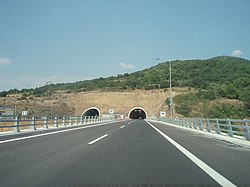Transport in Greece
 From Wikipedia - Reading time: 13 min
From Wikipedia - Reading time: 13 min
This article includes a list of references, related reading, or external links, but its sources remain unclear because it lacks inline citations. (January 2013) |
| Economy of Greece |
|---|
 |
| Overview |
| History |
| Related |

Transport in Greece has undergone significant changes in the past two decades, vastly modernizing the country's infrastructure and transportation. Although ferry transport between islands remains the prominent method of transport between the nation's islands, improvements to the road infrastructure, rail, urban transport, and airports have all led to a vast improvement in transportation. These upgrades have played a key role in supporting Greece's economy, which in the past decade has come to rely heavily on the construction industry.
Cable transport
[edit]

Rail transport
[edit]Railways
[edit]- total: 2,571 km (1,598 mi), (764 km or 475 mi are, or will be, electrified)
- standard gauge: 1,565 km (972 mi) 1,435 mm (4 ft 8+1⁄2 in) gauge
- narrow gauge: 961 km (597 mi) 1,000 mm (3 ft 3+3⁄8 in) gauge; 22 km (14 mi) 750 mm (2 ft 5+1⁄2 in) gauge
- dual gauge: 23 km (14 mi) combined 1,435 mm (4 ft 8+1⁄2 in) and 1,000 mm (3 ft 3+3⁄8 in) gauges (three rail system) (2004)
The state-owned company that owns and maintains Greece's railway network is OSE, Gaiose also a state-owned company owns and maintains railway stations, while Hellenic Train is the company responsible for operating all passenger trains and the most freight trains.
Metro
[edit]
Cities with a rapid transit railway network:
- Athens Metro (3 lines) (another one under construction)
- Thessaloniki Metro (2 lines) (Extension)
Commuter rail
[edit]
Cities with a commuter rail network (Proastiakos):
- Athens (4 lines)
- Thessaloniki (3 lines)
- Patras (2 lines)
Tram
[edit]
Road transport
[edit]Highways
[edit]- As of 2017, Greece has 2500 km of motorways.
Roads:
- total: 117,000 km
- paved: 107,406 km
- unpaved: 9,594 km (1996 est.)
- over 2500 tunnels (est.)
Bus transport
[edit]Urban bus transport
[edit]
- OSY subsidiary of Transport for Athens (OASA) organizes mass bus (Busses and trolleybuses) transit in Athens.
- OASTH organizes mass bus transit in Thessaloniki.
- Companies named Astiko KTEL provide mass bus transit in many of the other cities of Greece.
Intercity and regional bus transport
[edit]KTEL is the common name for every company which is responsible for intercity and regional bus transit. Most of the regional units, though, have their own regional network of buses, and have their regional unit names labeled on KTEL vehicles that operate there. (e.g. KTEL Argolidas).
There are 4 major bus terminals in Greece, the biggest is in Thessaloniki (Macedonia Inter city bus terminal) which serves all of Greece while Athens has 2 separate bus terminals serving different parts of Greece (Kifissos bus terminal and Liossion bus terminal). A new Athens bus terminal in Elaionas will replace the two separate terminals and serve all of Greece with completion by 2026. A new bus terminal in Patras which will replace the old one is currently under construction in Agios Dionyssios just 200m from the current one and it will open in late 2024 after many delays due to COVID-19 pandemic and the 2022 Russian invasion of Ukraine.
Water transport
[edit]Waterways
[edit]
The 80 km system consists of three coastal canals including the Corinth Canal (6 km) and three unconnected rivers.
The Corinth Canal crosses the Isthmus of Corinth, connecting the Gulf of Corinth with the Saronic Gulf; and shortens the sea voyage from the Adriatic to Athens port of Piraeus by 325 km.
Ports and harbours
[edit]- Alexandroupoli
- Argostoli
- Elefsina
- Ermoupolis
- Heraklion, Crete
- Kalamata
- Kavala
- Kerkyra
- Kos
- Chalkis
- Igoumenitsa
- Lavrio
- Patras
- Piraeus
- Port of Thessaloniki
- Volos
- Katakolo
- Mykonos
- Mytilene
- Rhodes (city)
- Souda
- Syros
Merchant marine
[edit]- total: 3,338 ships (with a volume of 1,000 gross tonnage (GT) or over) totaling 109,377,819 GT/182,540,868 tonnes deadweight (DWT)[1]
- ships by type (1999 est.)
- bulk carrier: 273
- cargo ship: 60
- chemical tanker: 22
- combination bulk: 5
- combination ore/oil: 8
- container ship: 43
- Liquified Gas Carrier: 5
- multi-functional large load carrier: 1
- passenger ship: 12
- passenger/cargo: 2
- petroleum tanker: 245
- refrigerated cargo: 3
- roll-on/roll-off ship: 19
- short-sea passenger: 75
- specialized tanker: 4
- vehicle carrier: 2
Airports
[edit]
- total: 82 (2005)
- With paved runways: 67
- over 3,047 m: 5
- 2,438–3,047 m: 16
- 1,524–2,437 m: 19
- 914–1,523 m: 17
- under 914 m: 10 (2005)
- With unpaved runways: 15
- 914 to 1,523 m: 3
- under 914 m: 12 (2005)
- heliports: 8 (2005)
Pipelines
[edit]- crude oil: 26 km
- petroleum products: 547 km
Major construction projects
[edit]Completed projects
[edit]Motorways
[edit]- A1 motorway (PAThE): 550 km (340 mi)
- A11 motorway
- A2 motorway (Egnatia Odos): 670 km (420 mi)
- A24 motorway
- A25 motorway
- A27 motorway (partially complete)
- A29 motorway: 77 km (48 mi)
- A3 motorway (Central Greece Motorway, part of the E65, partially complete)
- A5 motorway (Ionia Odos, partially complete): 196 km (122 mi)
- Rio–Antirrio bridge 2,880 metre long (9,449 ft) (2nd longest cable bridge in Europe
- A52 motorway
- A6 motorway (Attiki Odos): 69.7 km (43.3 mi)
- A62 motorway
- A621 motorway
- A64 motorway
- A7 motorway (Moreas Motorway): 205 km (127 mi)
- A71 motorway
- A8 motorway (Olympia Odos): 210 km (130 mi)
- A90 motorway (partially complete)
Railways
[edit]- Athens Airport–Patras railway (completed until Aigio)
- Thessaloniki–Alexandroupoli railway
- Athens Metro
Ports and harbours
[edit]Pireaus Port Rafina Port Lavrion Port
Airports
[edit]- Athens International Airport
- Thessaloniki Airport - "Makedonia"
Projects under construction
[edit]- North Road Axis of Crete
- Branches of Egnatia Odos
Railways
[edit]- Construction and electrification of extension to Patras of Athens Airport–Patras railway
- Line 4 (Athens Metro)
- Thessaloniki Metro
Ports and harbours
[edit]Airports
[edit]Future projects
[edit]Motorways
[edit]- Larisa–Kozane Motorway
- Eleusina-Oinofyta
- Attiki odos extension to Lavrio and Rafina
Railways
[edit]- Igoumenitsa–Ioannina–Kalampaka line
- Thessaloniki Metro extensions
- Athens metro line 5
- Kalampaka–Kastoria line
- Florina–Pogradec line
- Kalamaka–Kozani–Thessaloniki–Kavala–Toxotes line
- Ioannina–Rio line
- Thessaloniki–Chalkidiki line
- Thessaloniki–Giannitsa–Skydra line
- Chania–Rethymnon–Herakleion line
- Thessaloniki Tram
- Heraklion Tram
- Patras Tram
- Larisa Tram
- Ioannina Tram
- Volos Tram
Airports
[edit]See also
[edit]References
[edit] This article incorporates public domain material from The World Factbook. CIA.
This article incorporates public domain material from The World Factbook. CIA.
 KSF
KSF

